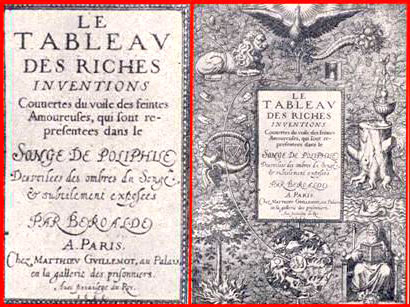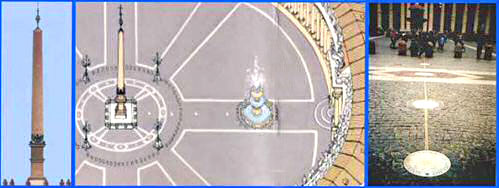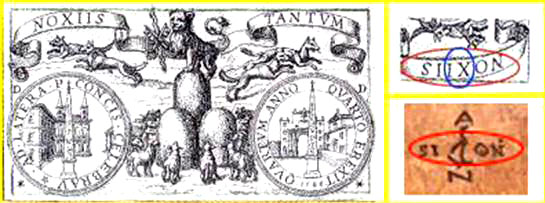I would like to write
something on acrostichs, and I chose this subject obviously for the
famous AOMPS, engraved on the base of the Calvarium, in the garden
of the Presbytery near the Magdalena of RLC.
Nothing that we do not know already: the acrostichs are short
poetical compositions where the initials of verses, read in vertical
direction, form a name or phrase (like on the tomb of Keats, in the
Acatholic Cemetery of the Pyramid of Cestia at Rome) or, as the
lovers of enigmas well know, it is about finding phrases where the
initials give a name or word.
Indeed, in the acrostich, from a clause we go to an abbreviation and
not vice versa. To describe the inverse procedure where we
reconstruct a clause from an abbreviation, we should use the word
"acronym" in reality.

The obvious example of a
"true" acrostich is given by Fr` Apostolo Zeno from the Convent of
the +Domenicani Osservanti delle Zattere; at Venice: we owe him
thanks for giving a name to the anonymous author of Hypnerotomachia
Polyphili, "Poliphile’s Dream".

In 1512, the Dominican
monk observed that: " librorum capita hoc ostendum, pro unoquoque
libro prima littera, itaque simul junctae dicunt: "POLIAM FRATER
FRANCISCVS COLVMNA PERAMAVIT" - "brother Francesco Colonna adored
Polia (Ippolita Tarvisi). " Here, the initials of the 38 chapters of
Hypnerotomachia forming the aforesaid acrostich :

The solution of a game
so complicated, distributed over so many pages, suggests proximity
to the author, if not his direct confidence. The latter
consideration (less irritating than the unlikely cipher "with 7
keys" with which Saunihre’s parchments were decrypted) would deserve
more attention, but we’re here to speak of AOMPS, not of +Strife of
Love Dreamed by Poliphile;.
An anagram remains relegated among its letters. If I say that +SION-AC-SION-PLUS;
(Sion and Sion again) is an anagram of +NICOLAS POUSSIN;, anyone can
observe it’s true. We can try to make others, but their number is
rather limited. An acronym can, on the other hand, give an almost
endless series of solutions whose limit is imposed by the
imagination only of the one deciphering.
But let’s return to our enigmatic inscription: "CHRISTUS AOMPS
DEFENDIT". Invoked is, last, Christ’s protection on the AOMPS. But
whom or what must the Lord defend?

Someone, as paraphrase
of the most famous Rosicrucian AMORC, has found it opportune to
read: "Antiquus Ordo Mysticus Prioratus Sionis", the Mystical and
Ancient Order of the Priory of Sion. A dear friend, member of an
Italian forum, reads it as: the Ancient Order Martinist of Pistis
Sophia. For someone else it means: "Alpha OMega Patris Sanguinis",
the beginning and end of the Stock of the Father. For others the
phrase is obvious: +Ab Opera Manifestum Patre Secretum;, Christ
defends with Work the Secret revealed by Father.
I know with certainty the AOMPS is a hierarchical high grade of "CCC",
a brotherhood of Parisian cataphiles whose adepts prowl and meet
each other in the bowels and sewers of the underground Agharta, the
Dark Town hiding its face a few metres under the mantle of the Ville
Lumihre which, on the other hand, is for all to see. But I do not
believe this Altier et Oublii et Magnifique PSycopomprs /Elevated
and Forgotten and Magnificent PSychopomp/ deserves "Divine
Protection" more than any of us.
Acronyms and abbreviations are so made: we can read almost all we
want.
I am lazy by nature and, fortunately, the case is simple. The
solution (and every Roman knows that) is provided by the base of the
obelisk erected by Sixtus V, "Er Papa Tosto", in 1586 in the middle
of San Pietro’s colonnade. Sixtus V was obsessed with obelisks: it
was the first of the four hoisted by the Pope, and his pontificate
lasted five years only!
Transported from Heliopolis to Rome in AD 37, under Caligula, the
Vatican monolith is a red granit of twenty-five metres, reaching
fourty if we add the base and the cross on the top. Like all
obelisks, it represents the +Ray of Ra;, the Sun. Like many, it
serves a big sundial as gnomon.

Among "exorcist"
inscriptions releasing it from pagan dependency, we read: "Christus
Ab Omni Malo Plebem Suam Defendat", at least in part taken from the
Litaniae Sanctorum. The arcana discovered, the mystery unveiled.
This phrase says explicity: "Christ keeps his people from all evil. "


On this point however
somebody could object an acrostich is used to point out to a few
which must pass unnoticed to many. You can assert "Ab Omni Malo
Plebem Suam"; is a better encrypted message of the simple AOMPS. The
former, as "phrase in clear", escapes the attention of the observer
who is attracted by the latter, in an attempt to give the
abbreviation +a sensible sense. Lighter than the language of men,
there is only the thought of men!!

Then we feel, only for a
minimum of historic data, our good sense keeps us from believing
Sixtus V was a Great Initiate who mastered radiesthesia and
geomantics, that he knew well the nodal points in the circulation of
telluric currents and did not want to hide, under this phrase,
another inexpressible truth relating to Sion.
But someone could again say historic notions and good sense lack the
precision of mathematical equation: Sixtus V displayed SION even
hiding in his heraldic device "NOXIIS TANTVM - Very for faults"

. . . and I say, to give
you the proof, only that the World and the Chance are still
unexplored languages.
ROMA ** XI - I - MMIV ** MD